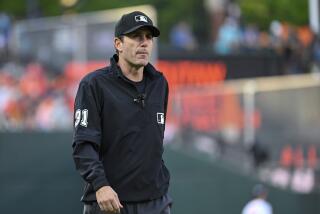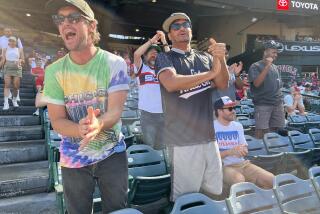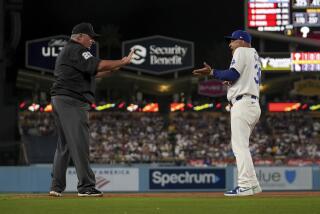Umpire Is Charged With the Error
- Share via
CHICAGO — For those of you who stopped screaming long enough to keep scoring at home, here’s how it went.
Error, blue.
Error, blue.
A double error. A four-base error. A Chicago-White-Sox-dancing-out-of-their-dugout-and-back-into-the-serie s error.
Don Denkinger, squared.
Umpiring the biggest series of his life, 37-year-old Doug Eddings made two errors in a span of two seconds Wednesday, mistakes that could change two team’s fortunes forever.
Cut through all the replays and rhetoric and the core of Game 2 of the American League championship series is clear enough to make one think the White Sox’s curse is gone, and the Angels’ curse is back.
Read this, Angel fans, and weep.
In the ninth inning, the White Sox’s winning run was scored by a runner who, with two out, reached base after being struck out and called out.
It’s that simple. It’s that outrageous.
The White Sox win, 2-1. The White Sox tie the series at one game apiece.
The Angels lose their composure. The Angels lose their minds.
It wasn’t entirely the umpire’s fault. The Angels’ young catcher, Josh Paul, also contributed to the problem with a mistake.
But it started with the umpire’s error, and when the history books are written, that is how it will end.
Just ask Don Denkinger, whose blown call in Game 6 of the 1985 World Series helped give the Kansas City Royals the championship.
“That’s the great thing, and terrible thing, about this game,” said the Angels’ Darin Erstad. “Every day, you see something you’ve never seen before.”
Here’s how it looked from here:
With two out in the ninth inning of a tie game, with nobody on base, the Angels’ Kelvim Escobar threw a split-finger fastball that caused A.J. Pierzynski to swing wildly for strike three.
Paul, the third-string catcher making his first appearance this postseason, caught the ball.
Eddings swung out his right arm in a “that’s a swing” motion, then balled up his right fist in a “you’re out” motion.
Paul rolled the ball toward the mound, and the Angels began running off the field.
Pierzynski, after taking a couple of steps toward the White Sox dugout, inexplicably began running to first base.
The Angels looked at him as if he were crazy. But, when Pierzynski reached first base untouched, it was the Angels who appeared crazy.
Safe, Eddings ruled.
What?
Safe, because Eddings had suddenly changed his call and ruled that Paul had trapped the ball and a catcher must legally catch a two-out strike.
Three pitches later, Joe Crede doubled into the left-field corner to win the game.
Somewhere, Scot Shields is still screaming and throwing his cap.
“You know what I think?” Paul said. “I think we should still be playing right now.”
The mistakes here were many. Let’s start from the moment the pitch crossed the plate, the moment that could change a season,.
The ruling that Paul trapped the ball? Wrong. Every replay I saw showed that he caught the ball. Even umpire supervisor Rich Rieker said later that it was, at best, inconclusive.
It was a close and difficult call. But just as this space would criticize a big-league player for botching a big-league grounder, so to must the umpires also be held equally accountable.
The second mistake was made by Paul. He claimed that, because he never heard Eddings shout, “no catch,” he assumed he caught the ball.
Bad assumption. He should have tagged the runner anyway. On anything close, catchers should always tag the runner just to be safe. You see this done by veteran catchers daily.
Veterans know that an umpire who shouts “no catch” is strictly offering a courtesy. Veterans know that, no matter what they hear, they should take no chances and always tag the guy.
But Paul’s mistake doesn’t mitigate Eddings’ first error of making the bad call, or his second error, which was this:
If you think he was safe, why on earth would you call him out?
The mechanics of Eddings’ call would not affect Paul, because Eddings was behind his back. But the rest of the Angels in the infield, including their first basemen, saw the “out” call.
“I rarely look up there, but this time I did, and I saw he was out,” Erstad said.
If a veteran such as Erstad thought the runner was not out, he would have called for the ball as it rolled to the mound, and perhaps one of his teammates could have grabbed it and thrown it to him.
This is Scioscia’s biggest complaint. The guy was called out, and the call was changed.
“Doug Eddings called him out, and somewhere along the line, because the guy ran to first base, he altered the call,” said Scioscia.
Eddings claimed that his hand-slash-followed-by-balled-fist motion is his normal call for a swinging strike. He said it is not his call for a strikeout.
“That’s my strike 3 mechanic,” he said.
Say what? That is as ridiculous as saying that a common “safe” call is really an “out” call.
Missing the trap call is understandable. Explaining that an “out” call is a “not-yet-out” call is utter nonsense.
The Angels didn’t play well. Vladimir Guerrero has disappeared in the frenzy. Chone Figgins has been swallowed by the moment. Scioscia agrees they didn’t do enough to win.
But in the end, a bad call cost them a very big game, and there’s no arguing that.
Bill Plaschke can be reached at bill.plaschke@latimes.com. To read previous columns by Plaschke, go to latimes.com/plaschke.
More to Read
Go beyond the scoreboard
Get the latest on L.A.'s teams in the daily Sports Report newsletter.
You may occasionally receive promotional content from the Los Angeles Times.







